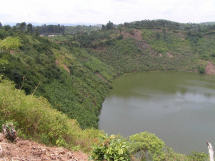Role of CO2 in the evolution of climate illuminated by its release from the deep earth in continents
14 November 2017
- CO2 stored slowly in the deep solid earth and released rapidly from continents has had a much greater role in shaping climate variations than previously thought
- Continents are 100-150 times more important than previously realised in releasing carbon into the atmosphere through volcanoes and along faults
- This work on the linking between solid Earth and atmosphere will lead to a complete picture of the evolution of climate.
New research has identified that the storage of CO2 in the deep solid earth and its release into our atmosphere has a much greater role in shaping past climate variations than previously thought.
Current understanding on the shaping of our climate has mapped the role of the ocean crust in releasing CO2 into the atmosphere, because here the crust is thin and the CO2 can get through more easily than in the continents.
In recent years, scientists have put more emphasis on studying the cycling of carbon deep in the solid Earth with a view to understanding the role of CO2 in the whole planet and not only in the atmosphere. The solid Earth has enormous reservoirs of carbon, which enters the atmosphere at volcanoes and along faults – huge cracks in the crust that are the sites of earthquakes.
The research, published today in Nature Geoscience, shows that the continents are 100-150 times more important in releasing carbon into the atmosphere than previously thought. This is just as much CO2 as released from the oceans, and it also goes directly into the atmosphere from the volcanoes, not needing to find its way through the water, giving it a more immediate effect.
In this study, the researchers Professor Stephen Foley, from the Department of Earth and Planetary Sciences and Professor Tobias Fischer of the University of New Mexico, matched the measured release of CO2 in the East African Continental Rift with its complex, long-term accumulation in the continents.
“We know that CO2 is important in the atmosphere as a greenhouse gas, but there is much more in the solid Earth than in the atmosphere. However, we don’t know much about how the two systems are linked, meaning at what rates how much of the CO2 within the Earth is released into the atmosphere, or by which mechanisms,” said Professor Foley.
Continental rifts are long, narrow fracture zones bound by faults along which continents eventually break apart in the plate tectonic process. These rifts have unusually high concentrations of carbonate-rich volcanic rocks and they are also the sites of massive degassing of CO2 along faults and at volcanoes – much higher than in other areas around the world. Despite this, attempts to budget carbon cycling through the inner Earth have not accounted for the role of continental rifts before now.
The key to the accumulation of CO2 in the continents is the depth of geological time: melts in the mantle formed over about three billion years have been sponged up at the bottom of the continents over that enormous time frame and released whenever rifts form. We know from high-pressure experiments that these melts contain large amounts of carbon.
Continental rifts are usually active for about 40 million years (just one per cent of the age of the Earth). Professors Foley and Fischer calculate that the carbon collected in this way is enough to account for the release of around 75 million tons of CO2 every year for the entire 40 million year history of a continental rift. This research promises to ‘close’ the carbon cycle, improving the links the solid Earth and climate carbon cycles.
“Up to now, attempts to balance a budget of carbon through the Earth and its atmosphere have been based on the modern Earth and have considered the continents to be insignificant. We show that the continents are much more important in releasing carbon into the atmosphere than previously thought, so we are placing continental processes firmly in the spotlight,” said Professor Foley.
An intriguing consequence of the role of continental rifts in the carbon budget concerns times at which all continents have been collected together, such as Pangaea about 250 million years ago.
“The life of these ‘supercontinents’ ends with them being broken up by an unusual abundance of continental rifts: at these significant times in Earth’s history, more than 600 million tons of CO2 per year may have been released, possibly directly contributing to warming of the atmosphere,” concluded Professor Foley.
This work on the linking between solid Earth and atmosphere should eventually lead to a complete picture of the evolution of climate – an explanation of how the current climate came into being.
Foley SF and Fischer TP. The essential role of continental rifts and lithosphere in the deep carbon cycle. Nature Geoscience. November 2017. doi.org/10.1038/s41561-017-0002-7
Filed under: Featured

